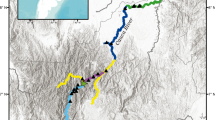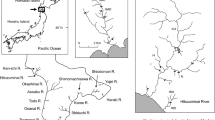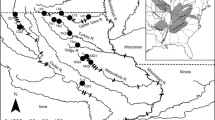Abstract
In river ecosystems, spatial complexity as well as anthropogenic factors operating at different temporal and spatial scales are shaping demography, connectivity and population genetic structure of species inhabiting these habitats. Chilina dombeiana is a freshwater gastropod with direct development (absence of a free larval phase) that inhabits the Biobío river basin in Chile (36°S). No studies have yet evaluated the spatial patterns of the genetic diversity of this species and the potential factors that influence these patterns. Consequently, in this study, we analyzed the population genetics of C. dombeiana based on 15 locations along the Biobío river. Eight microsatellite loci were genotyped. Also, at each sampling site, 40 environmental parameters were recorded to characterize them. Results showed that C. dombeiana has low genetic variability with high population structure. In addition, we detected signs of historical decreases in effective population sizes, unidirectional gene flow (upstream to downstream) and contemporary demographic bottleneck. Spatial subdivisions in populations showed a pattern of isolation by distance. The redundancy analysis and variance partitioning showed that spatial components and dissolved oxygen could explain 28% of the interpopulation genetic variation, while the Random Forest analysis identified significant effects of dissolved oxygen, nitrite and total coliforms on the genetic variability of populations (22%). Although C. dombeiana is widely distributed in Chilean rivers, its low dispersal and specific habitat requirements make this species very sensitive to the severe increase in anthropogenic disturbances affecting river ecosystems in recent decades. Long-term monitoring of genetic population conditions and environmental parameters are needed to implement robust management and conservation policies.






Similar content being viewed by others
Data availability
The authors have made their original microsatellite and physico-chemical data available at the Open Science Framework under the https://doi.org/10.17605/OSF.IO/HC8XY. The genetic (cGD) and hydrographic distances matrices are available on supplementary Material.
References
Alonso A, Camargo JA (2013) Nitrate causes deleterious effects on the behavior and reproduction of the aquatic snail Potamopyrgus antipodarum (Hydrobiidae, Mollusca). Environ Sci Pollut Res 20:5388–5396. https://doi.org/10.1007/s11356-013-1544-x
Bartram J, Padley S (1996) Microbiological analyses. In: Bartram J, Balance R (eds) Water quality monitoring. A practical guide to the design and implementation of freshwater quality studies and monitoring programmes. UNEP/WHO, Nairobi, pp 229–255
Beerli P, Felsenstein J (2001) Maximum likelihood estimation of a migration matrix and effective population sizes in n subpopulations by using a coalescent approach. Proc Natl Acad Sci USA 98:4563–4568
Belkhir K, Borsa P, Chikhi L, Raufaste N, Bonhomme F (1996–2004) GENETIX 4.05. Logiciel sous Windows TM pour la génétique des populations. Laboratoire Genome. Populations. Interactions. CNRS UMR 5000. Université de Montpellier II. Montpellier, France. Available from https://www.genetix.univmontp2.fr/genetix/intro.htm
Bertin A, Ruíz VH, Figueroa R, Gouin N (2012) The role of spatial processes and environmental determinants in microgeographic shell variation of the freshwater snail Chilina dombeyana (Bruguiére, 1789). Naturwissenschaften 99(3):225–232. https://doi.org/10.1007/s00114-012-0890-8
Bianco K, Yusseppone M, Otero S, Luquet C, Ríos de Molina M, Kristoff G (2013) Cholinesterases and neurotoxicity as highly sensitive biomarkers for an organophosphate insecticide in a freshwater gastropod (Chilina gibbosa) with low sensitivity carboxylesterases. Aquat Toxicol 144–145:26–35
Blanchet FG, Legendre P, Borcard D (2008) Modelling directional spatial processes in ecological data. Ecol Model 215:325–336
Blanchet G, Legendre P, Maranger R, Monti D, Pepin P (2011) Modelling the effect of directional spatial ecological processes at different scales. Oecologia 166:357–368. https://doi.org/10.1007/s00442-010-1867-y
Bórquez J, Brante A (2017) Paternity outcomes in the freshwater gastropod, Chilina dombeiana in the Biobío River. Chile PLoS One 12(1):e0169574. https://doi.org/10.1371/journal.pone.0169574
Bórquez J, Samollow PB, Douglas KC, Jasti M, Bertin A, Gouin N (2011) Characterization of microsatellite loci for the Chilean freshwater gastropod Chilina dombeiana. (Molecular Ecology Resources Primer Development Consortium. 2011. Permanent Genetic Resources added to Molecular Ecology Resources Database 1 February 2011–31 March 2011.) Mol Ecol Resour 11:757–758. Available from https://biomath.trinity.edu/manuscripts/11-4/mer-11-0072.pdf
Bórquez J, Valdovinos C, Brante A (2015) Intracapsular development in the freshwater gastropod Chilina dombeiana (Bruguière, 1789) (Gastropoda: Hygrophila: Chilinidae). Nautilus 129:169–171
Breiman L (2001) Random forests. Mach Learn 45(1):5–32. https://doi.org/10.1023/A:1010933404324
Breiman L, Cutler A, Liaw A, Wiener M (2015) randomForest: Breiman and Cutler´s Random Forests for Classification and Regression. R package version 4.6-12. Available from https://CRAN.R-project.org/package=randomForest
Burlakova L, Karatayev A, Karatayev V, May M, Bennet D, Cook M (2011) Endemic species: contribution to community uniqueness, effect of habitat alteration, and conservation priorities. Biol Cons 144:155–165
Byrne RA, Rundle SD, Smirthwaite JJ, Spicer JI (2009) Embryonic rotational behaviour in the pond snail Lymnaea stagnalis: influences of environmental oxygen and development stage. Zoology 112:471–477. https://doi.org/10.1016/j.zool.2009.03.001
Camara IA, Bony YK, Diomandé D, Edia OE, Konan FK, Kouassi CN, Gouréne G, Pointier JP (2012) Freshwater snail distribution related to environmental factors in Banco National Park, an urban reserve in the Ivory Coast (West Africa). Afr Zool 47(1):160–168
Carpenter SR, Stanley EH, Vander M (2011) State of the world’s freshwater ecosystems: physical, chemical, and biological changes. Annu Rev Environ Resour 36:75–99. https://doi.org/10.1146/annurev-environ-021810-094524
Caughley G, Gunn A (1996) Population viability analysis. In: Caughley G, Gunn A (eds) Conservation biology in theory and practice. Blackwell Science Ltd, Hoboken, pp 193–219
Cornuet JM, Luikart G (1996) Description and power analysis of two tests for detecting recent population bottlenecks from allele frequency data. Genetics 144:2001–2014
Dillon RT (2000) The ecology of freshwater molluscs. University Press, Cambridge
Di Rienzo A, Peterson AC, Garza JC, Valdes AM, Slatkin M (1994) Mutational processes of simple sequence repeat loci in human populations. Proc Natl Acad Sci USA 91:3166–3170
Dray S, Legendre P, Blanchet G (2009) packfor: forward selection with permutation (Canoco p. 46). R packcage version 0.0-8. Available from https://r-forge.r-project.org/R/?group_id=195
Dray S, Pélissier R, Couteron P, Fortin MJ, Legendre P, Peres-Neto PR, Bellier E, Bivand R, Blanchet FG, De Cáceres M, Dufour AB, Heegaard E, Jombart T, Muñoz F, Oksanen J, Thioulouse J, Wagner HH (2012) Community ecology in the age of multivariate multiscale spatial analysis. Ecol Monogr 82(3):257–275
Dudgeon D, Arthington AH, Gessner MO, Kawabata Z, Knowler D, Lévêque C, Naiman RJ, Prieur-Richard AH, Soto D, Stiassny MLJ, Sullivan CA (2006) Freshwater biodiversity: importance status and conservation challenges. Biol Rev 81:163–182
Dupanloup I, Schneider S, Excoffier L (2002) A simulated annealing approach to define the genetic structure of populations. Mol Ecol 11:2571–2581. https://doi.org/10.1046/j.1365-294x.2002.01650.x
Earl DA, von Holdt BM (2012) STRUCTURE HARVESTER: a website and program for visualizing STRUCTURE output and implementing the Evanno method. Conserv Genet Resour 4:359–361. https://doi.org/10.1007/s12686-011-9548-7
Escobar JS, Auld JR, Correa AC, Alonso JM, Bony YK, Coutellec MA, Koene JM, Pointier JP, Jarne P, David P (2011) Patterns of mating-system evolution in hermaphroditic animals: Correlations among selfing rate, inbreeding depression and the timing of reproduction. Evolution 65:1233–1253. https://doi.org/10.1111/j.1558-5646.2011.01218.x
Excoffier L, Lischer HEL (2010) Arlequin suite ver 3.5: a new series of programs to perform population genetics analyses under Linux and Windows. Mol Ecol Resour 10:564–567. https://doi.org/10.1111/j.1755-0998.2010.02847.x
Excoffier L, Smouse PE, Quattro JM (1992) Analysis of molecular variance inferred from metric distances among DNA haplotypes: application to human mitochondrial DNA restriction data. Genetics 131(2):479–491
Evanno G, Regnaut S, Goudet J (2005) Detecting the number of clusters of individuals using the software STRUCTURE: a simulation study. Mol Ecol 14:2611–2620
Fahrig L (1997) Relative effects of habitat loss and fragmentation on population Extinction. J Wildl Manag 61(3):603–610
Falush D, Stephens M, Pritchard JK (2003) Inference of population structure using multilocus genotype data: linked loci and correlated allele frequencies. Genetics 164:1567–1587
Frankham R (2005) Genetics and extinction. Biol Conserv 126:131–140
Frankham R, Ballou JD, Briscoe DA (2010) Introduction to conservation genetics, 2nd edn. Press Syndicate for the University of Cambridge, Cambridge
Fuller MR, Doyle MW, Strayer D (2015) Causes and consequences of habitat fragmentation in river networks. Ann NY Acad Sci 1355:31–51. https://doi.org/10.1111/nyas.12853
Gil JA, Belloso de Herrera G, Del Valle C, González V, Maza IJ, Sánchez MC, Bolívar CE, Martínez PD (2013) Evaluación de la calidad microbiológica y niveles de nitratos y nitritos en las aguas del río Guarapiche estado Monagas Venezuela. Rev Cient UDO Agric 13(1):154–163
Goldberg JI, Doran SA, Shartau RB, Pon JR, Ali DW, Tam R, Kuang S (2008) Integrative biology of an embryonic respiratory behaviour in pond snails: the “embryo stir-bar hypothesis”. J Exp Biol 211:1789–1736. https://doi.org/10.1242/jeb.016014
Goudet J (2001) FSTAT. A program to estimate and test gene diversities and fixation indices (version 2.9.3). Available from https://www2.unil.ch/popgen/softwares/fstat.htm
Gu QH, Husemann M, Ding BQ, Luo Z, Xiong BX (2015a) Population genetic structure of Bellamya aeruginosa (Mollusca: Gastropoda: Viviparidae) in China: weak divergence across large geographic distances. Ecol Evol 5:4906–4919. https://doi.org/10.1002/ece3.1673
Gu QH, Zhou CJ, Cheng QQ, Li XJ, Zhu GR, Zhang M, Gao YN, Dong J (2015b) The perplexing population genetic structure of Bellamya purificata (Gastropoda: Viviparidae): low genetic differentiation despite low dispersal ability. J Molluscan Stud 81:466–475. https://doi.org/10.1093/mollus/eyv017
Hannas BR, Das PC, Li H, LeBlanc GA (2010) Intracellular conversion of environmental nitrate and nitrite to nitric oxide with resulting developmental toxicity to the crustacean Daphnia magna. PLoS ONE 5:1–8
Hanski I (2011) Habitat loss, the dynamics of Biodiversity, and a perspective on conservation. Ambio 40:248–255. https://doi.org/10.1007/s13280-011-0147-3
Hedrick PW (2011) Genetics of populations, 4th edn. Jones and Barlett. Publishers. LLC., Boston
Jarne P (1995) Mating system, bottlenecks and genetic polymorphism in hermaphroditic animals. Genet Res 65:193–207
Jarne P, Delay B (1991) Population genetics of freshwater snails. TREE 6(12):383–386
Junge C, Museth J, Hindar K, KraabØl M, VØllestad A (2013) Assessing the consequences of habitat fragmentation for two migratory salmonid fishes. Aquat Conserv Mar Freshw Ecosyst 24(3):297–311. https://doi.org/10.1002/aqc.2391
Kalinowski ST (2005) HP-Rare: a computer program for performing rarefaction on measures of allelic diversity. Mol Ecol Notes 5:187–189
Kimura M, Ohta T (1978) Stepwise mutation model and distribution of allelic frequencies in a finite population. Proc Nat Acad Sci USA 75:2868–2872
Koopman KR, Collas FP, Van del Verde G, Verberk W (2016) Oxygen can limit heat tolerance in freshwater gastropods: differences between gill and lung breathers. Hydrobiologia 763:301–312. https://doi.org/10.1007/s10750-015-2386-y
Lande R (1998) Anthropogenic, ecological and genetic factors in extinction and conservation. Res Popul Ecol 40:259–269
Legendre P, Anderson MJ (1999) Distance-based redundancy analysis: testing multispecies responses in multifactorial ecological experiments. Ecol Monogr 69:1–24
Legendre P, Gauthier O (2014) Statistical methods for temporal and space–time analysis of community composition data. Proc Royal Soc B 281:20132728. https://doi.org/10.1098/rspb.2013.2728
Legendre P, Legendre L (2012) Numerical Ecology, 3rd edn. Elsevier, Oxford
Legendre P, Borcard D, Blanchet G, Dray S (2010) PCNM: PCNM spatial eigenfunction and principal coordinate analyses. R package version 2.1. Available from: https://R-Forge.R-project.org/projects/sedar/
Liaw A, Wiener M (2002) Classification and regression by randomForest. R News 2(3):18–22
Manni F, Guerard E, Heyer E (2004) Geographic patterns of (genetic, morphologic, linguistic) variation: how barriers can be detected by “Monmonier´s algorithm”. Hum Biol 76:173–190
Mavárez J, Amarista M, Pointier P, Jarne P (2002) Fine-scale population structure and dispersal in Biomphalaria glabrata, the intermediate snail host of Schistosoma mansoni, in Venezuela. Mol Ecol 11:879–889
Olmos V, George-Nascimento M (1997) El gremio de larvas de Digenea en el caracol del sur de Chile Chilina dombeyana: ¿qué indica la tasa metabólica de los hospedadores parásitados? Rev Chil de Hist Nat 70:109–118
Olmos V, Muñoz G (2006) Estado de conocimiento de los parásitos Eumetazoos de organismos dulceacuícolas de Chile. Gayana 70(1):122–139. https://doi.org/10.4067/S0717-65382006000100018
Pan T, Wang H, Duan S, Ali I, Yan P, Cai R, Wang M, Zhang J, Zhan H, Zhang B, Wu X (2019) Historical population decline and habitat loss in a critically endangered species the Chinese alligator (Alligator sinensis). Global Ecol Conserv 20:e00692. https://doi.org/10.1016/j.gecco.2019.e00692
Piry S, Luikart G, Cornuet JM (1999) Bottleneck: a computer program for detecting recent reduction in the effective population size using allele frequency data. J Hered 90:502–503. https://doi.org/10.1093/jhered/90.4.502
Pritchard JK, Stephens M, Donnelly P (2000) Inference of population structure using multilocus genotype data. Genetics 155:945–959
QGIS Development Team (2015) QGIS Geographic Information System. Version 2.18.24. Open Source Geospatial Foundation. 2017. Available from https://www.qgis.org/
R Development Core Team (2018) R: A Language and Environment for Statistical Computing. R Foundation for Statistical Computing. Vienna. Austria. Available from https://www.R-project.org
Rousset F (2008) GENEPOP´007: a complete re-implementation of the GENEPOP software for Windows and Linux. Mol Ecol Res 8:103–106
Saha B, Jahan MS, Hossain MA (2017) Ecology and abundance of Bellamya bengalensis (Lamarck. 1822) (Gastropoda: Viviparidae) in pond habitats of Rajshahi. Bangladesh J Sci Ind Res 52(2):107–114
Shukla S, Saxena A (2018) Global status of nitrate contamination in groundwater: its ocurrence. health impacts and mitigation measures. In: Hussain C (ed) Handbook of environmental materials management. Springer, Cham, pp 1–21
Song Z, Zhang J, Jiang X, Wang C, Xie Z (2013) Population structure of an endemic gastropod in Chinese plateau lakes: evidence for population decline. Freshw Sci 32(2):450–461. https://doi.org/10.1899/12-099.1
Soper DM, Delph L, Lively CM (2012) Multiple paternity in the freshwater snail. Potamopyrgus antipodarum. Ecol Evol 2:3179–3185. https://doi.org/10.1002/ece3.408
Städler T, Jarne P (1997) Population biology, genetic structure and mating system parameters. In: Streit B, Städler T, Lively CM (eds) Ecology and evolution of freshwater organisms. Birkhaüser Verlag, Basel, pp 231–262
Strayer DL, Dudgeon D (2010) Freshwater biodiversity conservation: recent progress and future challenges. J North Am Benthol Soc 29(1):344–358. https://doi.org/10.1899/08-171.1
Takahasi Y (2009) Characteristics of river systems. In: Dooge JCI (ed) Fresh surface water, vol 1. EOLSS Publishers/UNESCO, Oxford, pp 259–298
Taylor ML, Price TAR, Wedell N (2014) Polyandry in nature: a global analysis. Trends Ecol Evol 29:376–383
Tian-Bi YNT, Jarne P, Konan JNK, Utzinger J, N’Goran EK (2013) Contrasting the distribution of phenotypic and molecular variation in the freshwater snail Biomphalaria pfeifferi, the intermediate host of Schistosoma mansoni. Heredity 110:466–474. https://doi.org/10.1038/hdy.2012.115
Tian-Bi YNT, Konan JNK, Sangaré A, Ortega-Abboud E, Utzinger J, N’Goran EK, Jarne P (2018) Spatio-temporal population genetic structure, relative to demographic and ecological characteristics, in the freshwater snail Biomphalaria pfeifferi in Man, western Côte d’Ivoire. Genetica 147(1):33–45. https://doi.org/10.1007/s10709-018-0049-4
Tilman D, May RM, Lehman CL, Nowak MA (1994) Habitat destruction and the extinction debt. Nature 371:65–66
Trinidad-Ocaña C, Miranda-Vidal J, Juárez-Flores J, Barba-Macías E (2016) Distribución y diversidad de moluscos invasores de la familia Thiaridae en diferentes ambientes dulceacuícolas de Tabasco, México. Hidrobiológica 26(3):59–68. https://doi.org/10.24275/uam/izt/dcbi/hidro/2017v27n1/Barba
Valdovinos C (2006) Estado de conocimiento de los gastrópodos dulceacuícolas de Chile. Gayana 70:88–95
Valdovinos C, Balboa C (2008) Cercarial dermatitis and lake eutrophication in South-Central Chile. Epidemiol Infect 136(3):391–394. https://doi.org/10.1017/S0950268807008734
Valdovinos C, Parra O (2006) La Cuenca del Río Biobío: Historia Natural de un Ecosistema de uso múltiple. Publicaciones Centro EULA. Available from https://www.eula.cl/images/stories/documentos/3.pdf
Valdovinos C, Olmos V, Moya C (2005) Moluscos terrestres y dulceacuícolas de la cordillera de la Costa Chilena. In: Smith C, Armesto J, Valdovinos C (eds) Historia, biodiversidad y ecología de los bosques costeros de Chile. Editorial Universitaria, Santiago, pp 292–306
Van Heemst C, Willems J, Weller A, Van Verseveld H, Caamaño D, Aránguiz R (2013) Flood defense alternatives for the lower Biobío River. Chile. Obras y Proyectos 14:22–33
Van Oosterhout C, Hutchinson WF, Wills DPM, Shipley P (2004) MICRO-CHECKER: Software for identifying and correcting genotyping errors in microsatellite data. Mol Ecol Notes 4:535–538
Viard F, Bremond P, Labbo R, Justy F, Delay B, Jarne P (1996) Microsatellites and the genetics of highly selfing populations in the freshwater snail Bulinus truncates. Genetics 142:1237–1247
Waples RS, Do C (2008) LdNe: a program for estimating effective population size from data on linkage disequilibrium. Mol Ecol Resour 8:753–756
Weir BS, Cockerham CC (1984) Estimating F-statistics for the analysis of population structure. Evolution 38:1358–1370
Willi Y, Hoffmann A (2009) Demographic factors and genetic variation influence population persistence under environmental change. J Evol Biol 22:124–133. https://doi.org/10.1111/j.1420-9101.2008.01631.x
Wilson GA, Rannala B (2003) Bayesian inference of recent migration rates using multilocus genotypes. Genetics 163:1177–1191
Yang Q, Liu S, Li J, Wang D, Yu X (2019) Microsatellite evidence for multiple paternity in non-native populations of Pomacea canaliculata (Caenogastropoda: Ampullariidae) in China. Aquatic Invasions 14 (in press). Available from https://aquaticinvasions.net/2019/ACCEPTED/AI_2019_Yang_etal_correctedproof.pdf
Zhang L-J (2017) A new species of freshwater snail Tchangmargarya (Gastropoda: Viviparidae) endemic to a vanished small lake in Yunnan. China Molluscan Res 37:252–257. https://doi.org/10.1080/13235818.2017.1323369
Funding
This work was supported by the postdoctoral grant FONDECYT 3140561 to JB and FONDECYT 1170598 to AB.
Author information
Authors and Affiliations
Contributions
All authors have contributed equally to this work.
Corresponding author
Ethics declarations
Conflict of interest
The authors have declared that no competing interests exist.
Additional information
Publisher's Note
Springer Nature remains neutral with regard to jurisdictional claims in published maps and institutional affiliations.
Electronic supplementary material
Below is the link to the electronic supplementary material.
Rights and permissions
About this article
Cite this article
Bórquez, J., Valdovinos, C. & Brante, A. Genetic structure and diversity in the freshwater gastropod Chilina dombeiana in the Biobío River, Chile. Conserv Genet 21, 1023–1036 (2020). https://doi.org/10.1007/s10592-020-01308-z
Received:
Accepted:
Published:
Issue Date:
DOI: https://doi.org/10.1007/s10592-020-01308-z




